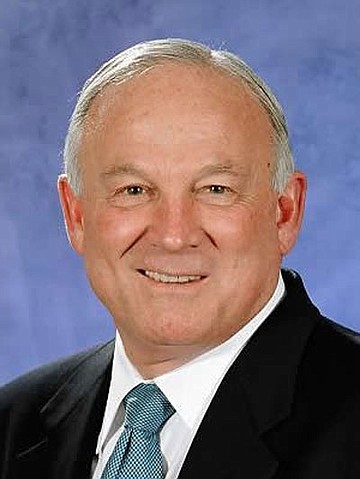 Facebook
Facebook
 X
X
 Instagram
Instagram
 TikTok
TikTok
 Youtube
Youtube

When the economy weakens, resolve stiffens. Glum consumers do fewer giddy things. It’s becoming apparent that lack of buying by debt-sated consumers could push us into another recession, or close to one, and the pain could last years.
In late July, Mark Fabiani, Chargers mouthpiece, lamented that the new state redevelopment law could crimp the team’s plan for a massively subsidized stadium downtown. Quoth Fabiani, “We now need to find alternative sources of funding.”
How about the Chargers themselves? If they want a stadium in this new economic reality, they can pay for it. Fabiani, of course, was not suggesting any such thing: he wants the stadium to be part of a subsidized sports and entertainment district. Voters should thumb that down as decisively as Long Island voters recently rejected $400 million of bonds for a hockey stadium.
Economists, viewing recent statistics (such as flat consumer spending) are increasingly predicting that we will have either a recession or extremely slow growth — very possibly prolonged.
New Jersey’s A. Gary Shilling, who has a great forecasting record, says the unemployment rate could hit 11.3 percent in 2013 and 12.4 percent in 2014. If housing prices drop another 17 percent (quite possible), the percentage of homes underwater (there is more debt on a home than it is worth) would rise from 23 to a horripilating 40.
“State and local governments will contract,” says Shilling, and that brings us to the proposed stadium. California has wised up. The new redevelopment law will keep the Chargers, and other pro teams in the state, from sucking up money that should go to schools and other worthy ventures. The Chargers admit that unless the California Supreme Court invalidates the new redevelopment laws, the team won’t be able to tap this source of funds until perhaps 2024 or 2025.
So now the team is angling for a taxpayer-financed sports and entertainment district. The proposed stadium would have a retractable roof and be used for conventions, basketball tournament games, rock concerts, and the like.

There are several roadblocks to this scheme: 1. Mayor Jerry Sanders and his allies, the convention center pushers, don’t want it; 2. The cost of the proposed facility would rise sharply. The Chargers (with their fingers crossed behind their backs) have long been saying that a new stadium would cost $800 million; put a retractable roof on top and the cost escalates; 3. Convention goers normally don’t like to walk between sites and there wouldn’t be enough events that require such a facility; 4. A covered stadium in a Mediterranean climate is asinine for the major use, football games.
The big question is where the money will come from. For some time, the Chargers have said they would put in $200 million and hope to get another $100 million to $150 million in loans from the National Football League. That league well is dry right now, but the recent agreement between owners and players permits teams to borrow money again.
But if the stadium is to be roofed and engineered for other events, what will it cost? Nine hundred million dollars? A billion? I asked Mark Fabiani, Chargers spokesman, about some of the details. For example, would naming and advertising rights be subtracted from the Chargers’ contribution? Would the Chargers plunk in $200 million of capital or would their contribution come from cash flow from the stadium? Just how much would the Spanos family put in the pot? His answer: “The amount of the combined Chargers-[National Football League] contribution is now the subject of negotiations with the City, but we expect the amount to be in line with what other NFL teams that have reached similar agreements in recent years have contributed to their new stadiums.”
Oh? Really? In Los Angeles, there is a plan to build a $1.2 billion stadium with private funds. The project will be tied to the convention center (as the Chargers propose in San Diego). The city will sell bonds to pay for a new convention center wing, but, supposedly, the bonds will be paid off with revenue coming from the center and the new stadium. (Well, maybe.)
In any case, a bundle of private capital is going into the proposal by Anschutz Entertainment Group. (Admittedly, Philip Anschutz is worth $7.5 billion and the Spanos family a paltry $1.1 billion, according to this year’s compilation by Forbes magazine. And the L.A. market is far bigger and richer than San Diego’s.) Still, L.A., unlike San Diego, demands private financing.
Similarly, the San Francisco 49ers aim to build a stadium in Santa Clara. The city is only kicking in $79 million of the billion-dollar cost. Hotel taxes should add another $35 million. (The change in redevelopment laws could alter current plans.) Since the 49ers’ owners may not be able to come up with their share of the money, the Oakland Raiders may chip in and play at the stadium, too.

All over the United States, proposals to build stadiums are in flux. “They haven’t put out the details,” says former councilmember Bruce Henderson. “The devil is in the details, and if you don’t have details, then you know you are dealing with the devil.” Amen.
Vanderbilt University economist John Vrooman estimates that in the early 1990s, before the league began its loan program, teams were only putting in 27 percent of stadium costs. Then after the league began providing loans, that percentage rose to 60.
What the Chargers propose to pay is closer to the percentage that teams put in before the league’s loan program began, and quite possibly less.
This is hardly surprising because, all along, the team has been going down two tracks. It prefers to be the organization (perhaps one of two) occupying the stadium in L.A., if it ever gets built. But if the team can’t get L.A., it wants a San Diego commitment in its back pocket.
As now anticipated, this would be a smelly deal. Perhaps deliberately. The Chargers may want to be able to tell the league that San Diego just wouldn’t cooperate and therefore they should get permission to go to L.A.
Henderson notes that in the deal in which former mayor Dick Murphy ended the 60,000-seat guarantee, costing the City $100 million in rent, “The Chargers do not have to reveal that they are talking to anyone. They only have to give notice [of pending departure] in the period beginning in February, after the season, after the Super Bowl; notice doesn’t have to be given during a period that gives any disruption to the team. We proved to be Super Suckers.”
Maybe economic reality will prevent that happening again.


When the economy weakens, resolve stiffens. Glum consumers do fewer giddy things. It’s becoming apparent that lack of buying by debt-sated consumers could push us into another recession, or close to one, and the pain could last years.
In late July, Mark Fabiani, Chargers mouthpiece, lamented that the new state redevelopment law could crimp the team’s plan for a massively subsidized stadium downtown. Quoth Fabiani, “We now need to find alternative sources of funding.”
How about the Chargers themselves? If they want a stadium in this new economic reality, they can pay for it. Fabiani, of course, was not suggesting any such thing: he wants the stadium to be part of a subsidized sports and entertainment district. Voters should thumb that down as decisively as Long Island voters recently rejected $400 million of bonds for a hockey stadium.
Economists, viewing recent statistics (such as flat consumer spending) are increasingly predicting that we will have either a recession or extremely slow growth — very possibly prolonged.
New Jersey’s A. Gary Shilling, who has a great forecasting record, says the unemployment rate could hit 11.3 percent in 2013 and 12.4 percent in 2014. If housing prices drop another 17 percent (quite possible), the percentage of homes underwater (there is more debt on a home than it is worth) would rise from 23 to a horripilating 40.
“State and local governments will contract,” says Shilling, and that brings us to the proposed stadium. California has wised up. The new redevelopment law will keep the Chargers, and other pro teams in the state, from sucking up money that should go to schools and other worthy ventures. The Chargers admit that unless the California Supreme Court invalidates the new redevelopment laws, the team won’t be able to tap this source of funds until perhaps 2024 or 2025.
So now the team is angling for a taxpayer-financed sports and entertainment district. The proposed stadium would have a retractable roof and be used for conventions, basketball tournament games, rock concerts, and the like.

There are several roadblocks to this scheme: 1. Mayor Jerry Sanders and his allies, the convention center pushers, don’t want it; 2. The cost of the proposed facility would rise sharply. The Chargers (with their fingers crossed behind their backs) have long been saying that a new stadium would cost $800 million; put a retractable roof on top and the cost escalates; 3. Convention goers normally don’t like to walk between sites and there wouldn’t be enough events that require such a facility; 4. A covered stadium in a Mediterranean climate is asinine for the major use, football games.
The big question is where the money will come from. For some time, the Chargers have said they would put in $200 million and hope to get another $100 million to $150 million in loans from the National Football League. That league well is dry right now, but the recent agreement between owners and players permits teams to borrow money again.
But if the stadium is to be roofed and engineered for other events, what will it cost? Nine hundred million dollars? A billion? I asked Mark Fabiani, Chargers spokesman, about some of the details. For example, would naming and advertising rights be subtracted from the Chargers’ contribution? Would the Chargers plunk in $200 million of capital or would their contribution come from cash flow from the stadium? Just how much would the Spanos family put in the pot? His answer: “The amount of the combined Chargers-[National Football League] contribution is now the subject of negotiations with the City, but we expect the amount to be in line with what other NFL teams that have reached similar agreements in recent years have contributed to their new stadiums.”
Oh? Really? In Los Angeles, there is a plan to build a $1.2 billion stadium with private funds. The project will be tied to the convention center (as the Chargers propose in San Diego). The city will sell bonds to pay for a new convention center wing, but, supposedly, the bonds will be paid off with revenue coming from the center and the new stadium. (Well, maybe.)
In any case, a bundle of private capital is going into the proposal by Anschutz Entertainment Group. (Admittedly, Philip Anschutz is worth $7.5 billion and the Spanos family a paltry $1.1 billion, according to this year’s compilation by Forbes magazine. And the L.A. market is far bigger and richer than San Diego’s.) Still, L.A., unlike San Diego, demands private financing.
Similarly, the San Francisco 49ers aim to build a stadium in Santa Clara. The city is only kicking in $79 million of the billion-dollar cost. Hotel taxes should add another $35 million. (The change in redevelopment laws could alter current plans.) Since the 49ers’ owners may not be able to come up with their share of the money, the Oakland Raiders may chip in and play at the stadium, too.

All over the United States, proposals to build stadiums are in flux. “They haven’t put out the details,” says former councilmember Bruce Henderson. “The devil is in the details, and if you don’t have details, then you know you are dealing with the devil.” Amen.
Vanderbilt University economist John Vrooman estimates that in the early 1990s, before the league began its loan program, teams were only putting in 27 percent of stadium costs. Then after the league began providing loans, that percentage rose to 60.
What the Chargers propose to pay is closer to the percentage that teams put in before the league’s loan program began, and quite possibly less.
This is hardly surprising because, all along, the team has been going down two tracks. It prefers to be the organization (perhaps one of two) occupying the stadium in L.A., if it ever gets built. But if the team can’t get L.A., it wants a San Diego commitment in its back pocket.
As now anticipated, this would be a smelly deal. Perhaps deliberately. The Chargers may want to be able to tell the league that San Diego just wouldn’t cooperate and therefore they should get permission to go to L.A.
Henderson notes that in the deal in which former mayor Dick Murphy ended the 60,000-seat guarantee, costing the City $100 million in rent, “The Chargers do not have to reveal that they are talking to anyone. They only have to give notice [of pending departure] in the period beginning in February, after the season, after the Super Bowl; notice doesn’t have to be given during a period that gives any disruption to the team. We proved to be Super Suckers.”
Maybe economic reality will prevent that happening again.
Comments